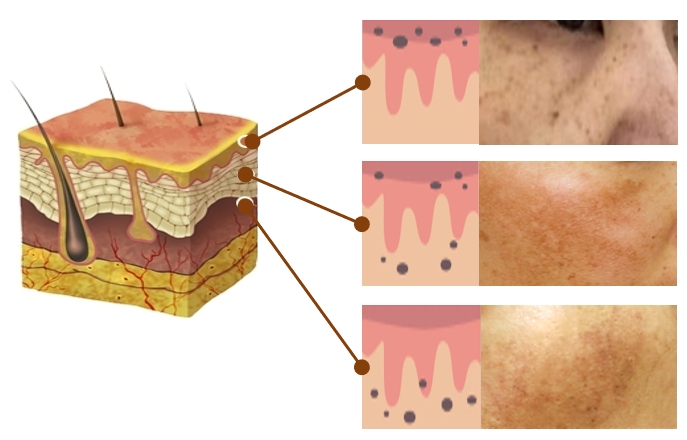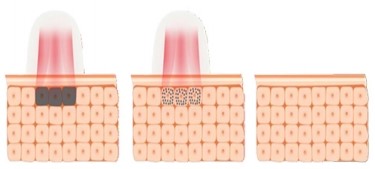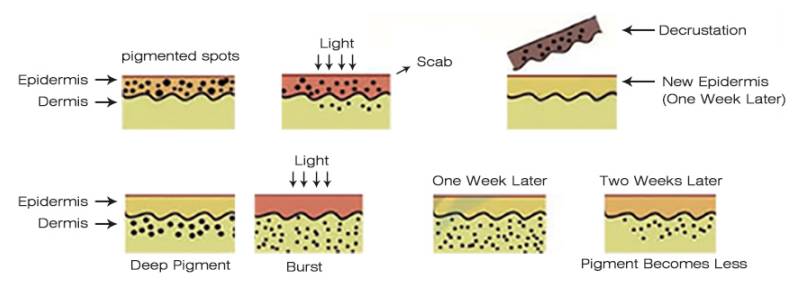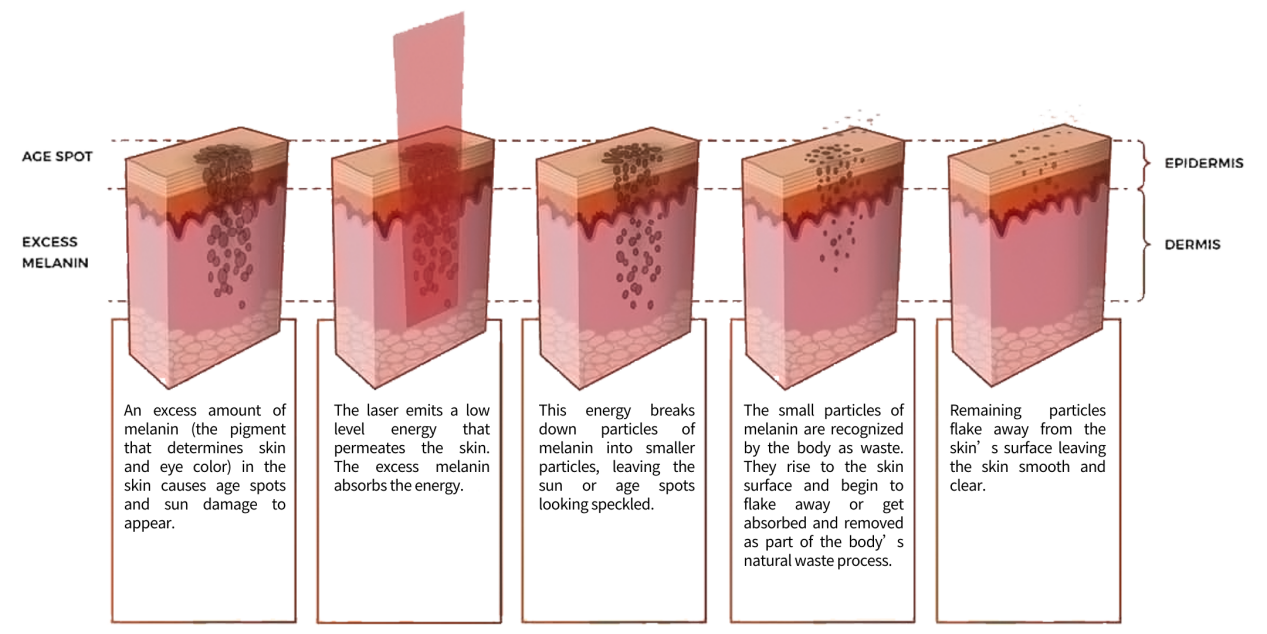Types & Causes of Pigmentation
Pigmentation refers to the coloring of the skin, hair, mucous membranes, and retina of the eyes. The main types of pigmentation in humans are caused by the pigment melanin, produced by cells called melanocytes.

Pigmentation refers to the coloring of the skin, hair, mucous membranes, and retina of the eyes. The main types of pigmentation in humans are caused by the pigment melanin, produced by cells called melanocytes.
Based on the persistence and the depth of the skin layer, we can classify the pigmentation as follows:
|
Persistence of Pigmentation |
|
|
Transient Pigmentation |
Due to the activity of tyrosinase, it is temporary and can fade over time or with appropriate treatment. It is affected by external light and endocrine factors, and the color depth may change due to inflammation, injury, or medication. The common ones include melasma, sunburn, pregnancy spots, black spots, and post-inflammatory hyperpigmentation (PIH) following acne, etc. |
|
Persistent Pigmentation |
This pigmentation is long-lasting and does not fade easily over time. It's often due to permanent changes in melanocytes or their distribution. Conditions like genetic plaques, senile plaques, melasma, certain types of moles, and freckles fall under this category. Even if removed, it is prone to recurrence, so persistent pigmentation may require ongoing management and treatment. |

·Epidermal Pigmentation: This type of pigmentation occurs in the outermost layer of the skin, the epidermis. It's typically characterized by a well-defined, darker appearance and can be caused by an increase in melanin production. Conditions like freckles, age pigment, sunburn, and pigmented nevi are examples of epidermal pigmentation.
·Mixed Epidermal and Dermal Pigmentation: Some pigmentation disorders involve both the epidermal and dermal layers. These can present in varying colors and are often more challenging to treat. Melasma/Chloasma, lead mercury spots, sunburn, pregnancy spots, black spots, freckles, etc., are examples that can have a mixed pattern, with both epidermal and dermal involvement.
·Dermal Pigmentation: Dermal pigmentation occurs in the deeper layer of the skin, the dermis. It often has a bluish or grayish hue due to the melanin being deeper in the skin. Examples include certain types of birthmarks and pigmentation due to long-standing venous stasis like nevus of Ota and naevus fusco-caeruleus zygomaticus.
Common Treatment Equipment & Principles
Pigmentation treatment can utilize various medical aesthetic equipment, each with its unique treatment principles and indications. Here are some common devices used for pigmentation:
·Intense Pulsed Light (IPL)
Principle: It emits broad-spectrum light that specifically targets and breaks down pigment in the skin.
Application: Suitable for various superficial pigmentary issues, such as freckles and sunspots.
·Q-Switched Laser
Principle: Uses specific wavelengths to produce short, high-energy pulses of light that target melanin particles.
Application: Highly effective for deeper pigmentation issues, such as post-acne hyperpigmentation and café-au-lait spots.
·Picosecond Laser
Principle: Similar to Q-Switched lasers, it generates even shorter pulses, providing more precise treatment.
Application: Used for deeper or more stubborn pigmentation, it also helps improve skin texture.
·Fractional Laser
Principle: Produces micro-fine laser beams to treat the skin in a fractional manner, promoting skin renewal and repair.
Application: This product is suitable for various pigmentation issues and helps improve overall skin texture.
·Microneedling
Principle: It stimulates the skin through tiny needles, promoting collagen production, and can be combined with specific skin-lightening products.
Application: helpful in improving skin pigmentation, unevenness, and overall skin tone.
Principles and Advantages of Different Equipment
IPL / DPL
IPL (Intense Pulsed Light) describes the use of intense pulses of non-coherent light distributed over a range of wavelengths from 400nm to 1200nm. The technology utilizes specific wavelength ranges to target various chromophores in the skin. This enables effective treatment of a broad spectrum of conditions, including acne, vascular and pigmented lesions, skin photoaging treatments, and hair removal.
DPL (dynamic pulsed light) is considered an advancement over IPL. It combines both laser and light technology, leading to a more targeted approach.
The main difference between IPL and DPL is that IPL utilizes a single light source, while DPL uses multiple pulsed lights at different wavelengths to provide outstanding results for safer, faster, and more comfortable treatments. Additionally, IPL is typically used to target surfaces, while DPL can be used to target deeper layers of skin.

It adopts the “selectively thermal absorption of laser” principle. When the specific wavelength of light acting on the skin is absorbed selectively by the melanin of diseased tissue (the content of melanin in diseased tissue is much higher than that of normal tissue), Some of the melanin in the deep layer will be cracked for fine particles, and the particles will be swallowed by the phagocyte and expelled from the body by the lymphatic system. Some of the melanin in the superficial tissue will pop out of the epidermis,and then the color of the epidermis pigment will be deeper. The melanin will drop with the skin cuticle metabolism. Thus, the freckle will fade away.However, normal skin absorbs less energy, and there is strong epidermis cooling technology to protect it.Therefore, normal skin wo'n't be hurt, and at the same time, the skin's complexion will improve.

Advantages of IPL / DPL in Pigmentation Treatment
· Broad Spectrum: IPL utilizes a broad spectrum of light with various wavelengths, allowing it to target different types of pigmentation in the skin.
· Surface-Level Treatment: It is effective for treating superficial skin concerns, making it suitable for light freckles that are not deeply set in the skin.
· Versatility: IPL can treat a range of skin issues simultaneously, such as redness, fine lines, and uneven skin tone, along with freckles.
· Skin Rejuvenation: Besides targeting pigmentation, IPL promotes collagen production, enhancing overall skin texture and quality.
· Best for Lighter Skin Tones: IPL is typically more effective and safer for individuals with lighter skin tones due to the risk of hyperpigmentation in darker skin types.
· Treatment Area: It is well-suited for treating larger areas of skin with diffuse freckling.
Q-Switched Nd:Yag

Nd:YAG (Neodymium-doped Yttrium Aluminum Garnet) is a crystal used as a laser medium. "Q-switched" refers to the technique of producing a high-intensity laser beam in very short pulses (nanoseconds). This allows the laser to emit powerful bursts of light energy in a controlled manner. The Q-switched Nd:YAG laser operates primarily at two wavelengths: 1064 nm and 532 nm.
The Q-Switched Nd:YAG laser is an effective treatment for various skin pigmentation issues, utilizing the principle of selective photothermolysis. It emits specific wavelengths of 532 nm and 1064 nm that are absorbed by melanin, causing the pigment particles to heat up and fragment. These smaller particles are then naturally removed by the body's immune system, leading to a gradual fading of the pigmented lesions. The laser's quick, high-energy pulses minimize damage to surrounding tissue, making it a safe option for treating age spots, sun spots, freckles, melasma, and some birthmarks.
Advantages of Q-switched Nd:YAG Laser in Pigmentation Treatment
· Targeted Precision: The Q-Switched Nd:YAG laser emits light at specific wavelengths, allowing precise targeting of pigmentation, ideal for isolated and darker freckles.
· Deep Penetration: The laser can reach deeper layers of the skin, making it effective for freckles that are more prominent or set deeper in the skin.
· Safe for Darker Skin Tones: It is generally safer for use on darker skin tones compared to IPL, with a lower risk of causing hyperpigmentation or hypopigmentation.
· Effective for Stubborn Pigmentation: The Q-Switched Nd:YAG is particularly effective in breaking down stubborn or dense pigmentation.
· Rapid Results: Often, results can be seen faster with the Q-switched Nd:YAG laser, especially for targeted, specific areas of pigmentation.
· Minimal Heat Damage: The quick, intense pulses minimize heat damage to surrounding tissue, reducing the risk of scarring or other side effects.
The Q-Switched Nd:YAG laser's mechanism of targeting melanin with high-intensity, short-duration pulses makes it an effective and safe option for freckle removal. Its precision and efficacy in shattering pigment particles while preserving surrounding tissue integrity make it a preferred choice in cosmetic dermatology.
Precautions During Treatments
· Sun Protection: Always use broad-spectrum sunscreen with SPF 30 or higher.
· Skin Care Regimen: Follow a gentle skincare routine to avoid further irritation.
· Regular Follow-ups: Monitor skin response and adjust treatments as needed.
· Avoiding Certain Medications: Some medications can worsen pigmentation. Consult your doctor before starting treatment.
· Dietary Control: It is recommended to consume fresh and healthy foods during the treatment period and to control the intake of oil, salt, sugar, spicy foods, and other stimulating foods.
· Patient Selection: Not all populations are ideal candidates for IPL or Q-switched laser, such as those who have photosensitive signs or taken photosensitive drugs, have undergone some invasive skin treatment projects in the past week, or have used effective skincare products within three months. Many other prohibited populations are not eligible for treatment. Therefore, a thorough skin assessment, multiple intensive treatments, and a professional doctor's consultation during treatment are crucial to achieving optimal results.
Menu
Recommended for you

How IPL Laser Works: A Comprehensive Guide | CIELLULU

Invitation to Vietbeauty 2024: Join Ciellulu Laser at Vietnam’s Premier Beauty Trade Show

IPL vs Laser Hair Removal: Choosing the Right Option for You | CIELLULU
Immediate Skin Responses to Laser and Light Treatments for IPL laser skin treatment - Warning endpoints: How to avoid side effects
You may also like

CIELLULU S500 1500W Diode Laser Hair Removal & Skin Rejuvenation Machine
Diode Laser Painless Hair Removal Machine is especially effective on hair follicle melanocytes without causing damage to the surrounding tissue.

CIELLULU MULA K2 BroadBand Light DPL beauty machine for skin care and hair removal
ACNE/Pigmentation/Vascular Lesions Treatment, Skin Rejuvenation and Hair Removal.

CIELLULU Q-Switched ND:YAG Laser LIFFAN Q6
Pigment Removal & Tattoo Removal & Skin Rejuvenation
If you have any comments or good suggestions, please leave us a message. Later, our professional staff will contact you as soon as possible.
Copyright © 2024 CIELLULU Designed by gooeyun. | Privacy Policy • Terms and Conditions








